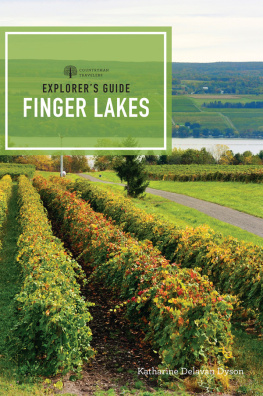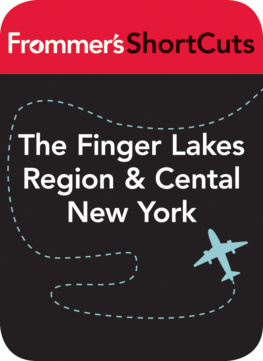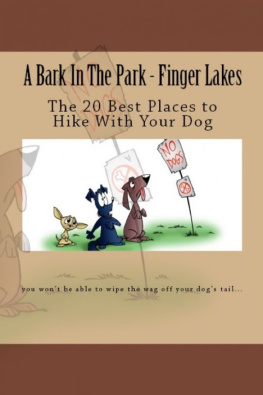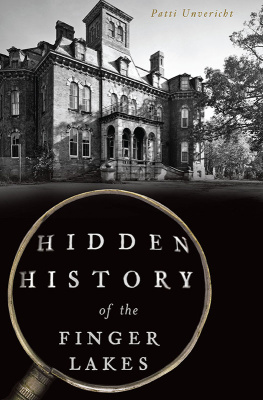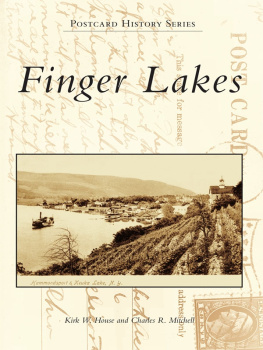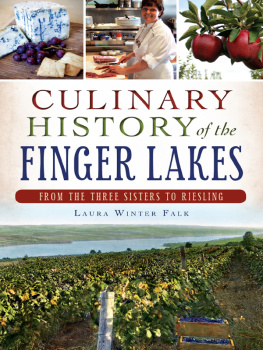

This book is dedicated to those optimistic souls who appreciate
the wonder of the world around them and have the passion
to discover something new each day.
EXPLORE WITH US!
This book covers the region of the Finger Lakes around or within easy driving distance of the lakes, an area that falls approximately inside the perimeter of a rough circle drawn along the New York State Thruway (Interstate 90), US 81, NY 17, and US 390 and stretching from Syracuse to Rochester and south to Ithaca. It encompasses 11 lakes (plus a few smaller lakes) in an area of about 90 miles by 60 miles.
A general history of the region is followed by an overview of the best routes into the areaby land, air, and water. The lake areas are described in five chapters: Skaneateles, Owasco, and Otisco Lakes, Cayuga Lake, Seneca Lake, Keuka Lake, and Canandaigua Lake (including Canadice, Conesus, Hemlock, and Honeoye). Within each of these chapters, you will find information about everything from history, lodging, and restaurants to recreation, shopping, and cultural attractions arranged under the town or area where they are located.
Find suggestions for special interests ranging from family escapes and romantic getaways to exploring wine trails and seasonal pleasures. Places to stay are geared to visitors interests and needs. A Wine & Beer section in each chapter highlights a robust selection of itineraries. Features in major citiesSyracuse, Rochester, Corning, Elmira, and Cortlandare described in a separate chapter. The last chapter, Information, gives Finger Lakes facts and figures.
In the index you will find lodging and dining facilities. Every effort has been made to place towns and villages in the chapter that covers the lake (or lakes) nearest to the place. Still, there are coin tosses on some spots that straddle an area between two lakes. In this case the index can be your best guide.
Although all information was as accurate as possible as of publication, I suggest that you call ahead before visiting. Please note that many places are open only during the warmer months, usually from mid-April through mid-October.
PRICES Since the Finger Lakes region is most active with visitors during the warmer months, you can expect prices to be higher at that time, especially for lodging. In addition to higher prices during the popular months, you may also find that some places require a two- or three-night minimum. Cabin or house rentals may require a one-week minimum. Off-season is a different story. But always ask.

BOATS ARE ALL FITTED OUT FOR JULY 4TH
A general price range is given with lodging prices per room, double occupancy, and may or may not include breakfast or other meals. Restaurant prices indicate the cost of a meal for one person including an appetizer or salad, main course, and dessert. Bar beverages are extra.
LODGING PRICE CODES: | DINING PRICE CODES: |
$: Up to $75 per couple | $: Up to $10 |
$$: $76$150 per couple | $$: $11$25 |
$$$: $151$250 per couple | $$$: $26$40 |
$$$$: More than $250 per couple | $$$$: More than $40 |
I welcome your comments on the content of the book and any personal experiences you care to share. A major effort was made to include all key historic sites and attractions as well as a wide variety of lodgings, restaurants, retail establishments, and other places of interest. The purpose of this book, however, was not to include everything but to provide you with a good sense of what there is in order to entice you to explore further, and to give you contact points, typically websites, phone numbers, and addresses, so you may get more particulars as needed.
Check out my website for more information, updates, and ongoing events: www.FingerLakesInfo.com.

CONTENTS
A s you drive through the rolling hills and valleys of the Finger Lakes, where summer brings Friday-night band concerts, acres of thriving vineyards, and sails darting across lakes, you are mindful that this region is one of the most beautiful on earth. The crystalline waters of more than 11 lakes nestle in the valleys, horses graze in meadows, corn and wheat fields create crazy-quilt patterns across the landscape, and waterfalls plunge into deep gorges.
Summer means sailboats tacking from shore to shore; endless fields of tasseled corn, alfalfa, and wheat; flashes of goldenrod, china-blue chicory, purple horsemint, and buttercups along with warm-soft evenings sparkled by the fleeting beacons of lightning bugs.
High school and college football games kick off the orange-red glow of fall, which quickly turns brisk as grapes and apples are harvested and dry bundles of corn stand like sentries in the countryside against deep lapis skies. Winter ushers in drifts of snow and ice-covered trees. Skiers take to the slopes; skaters clear snow off lakes and ponds and glide onto the ice; and snowmobiles forge new trails across pristine white fields. Spring blossoms with sweet-scented blue, pink, and white lilacs, tulips, daffodils, and clouds of forsythia, while hundreds of waterfalls burst over outcroppings of rocks, diving to icy pools below.
There are vibrant cities like Rochester, Ithaca, and Syracuse; and picture-postcard villages with expansive lawns and white-clapboard houses with front porches armed with wicker furniture and window boxes brimming over with petunias, ivy, and geraniums. There are mansions, like Sonnenberg in Canandaigua; the amazing Corning Glass Center; Watkins Glen International Raceway; and a handful of old-fashioned ice-cream parlors, wooden-floored hardware stores, and drive-in movie theaters from the 50s.
Creating a vibrant atmosphere of continual growth and cultural opportunities are Syracuse University, RIT (Rochester Institute of Technology), Cornell University, University of Rochester, Ithaca College, Wells College, Hobart and William Smith Colleges, Keuka College, and others.
Many of the original settlers in the region were farmers, and today a strong farm population still exists. Drive along country roads and youll pass billboards promoting farm machinery, huge blue Harvestore silos, and a patchwork of plowed fields defined by tightly woven stands of trees and hedgerows. Signs along the road warn of cows or tractors crossing and advertise homemade products: stacked rows of split firewood, fruits and vegetables, cut flowers, and piles of corn.
At the end of the day as the sun melts into the horizon, you are sure to see black-and-white Holsteins crowding the gates, their udders heavy with milk, as they wait for farmers to take them into the barn and relieve them of their bounty.
In towns like Moravia, Auburn, Geneva, Aurora, Canandaigua, and Skaneateles, much of the eighteenth-century architecture has been preserved; while a reminder of our Native American heritage is found at the Ganondagan State Historic Site in Victor, a seventeenth-century Native American settlement, just outside Rochester.
Many of the pleasant little towns like Homer, Avon, and Dresden, anchored by farmland on either end, usually have shops worth browsing, a barn full of antiques piled helter-skelter, a place to eat, or a nice bed-and-breakfast. Some shops post their hours as open by chance or appointment. This lack of commercial hype promises a few days escape from the corporate treadmills. In the Finger Lakes, the pace is kinder. Gridlock? What gridlock?
Next page
